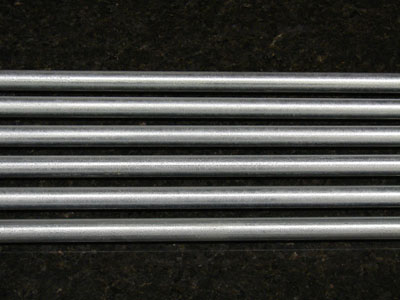

Specialists: Selective Plating
26260 Eden Landing Road , Hayward, California 94545
Phone: (510) 781-5588 Fax: (510) 781-5589
Email: tmartin@platron.com
How electro deposition works.
Well technically, itís electrochemical deposition. When a metallic salt is dissolved in ultra pure water it dissociates to form positively charged ions. The solution that contains these charged ions is referred to as an electrolyte or a plating solution. By passing a sufficient amount of direct (not alternating) electric current through this electrolyte, one can reduce the metal ions to form solid metal. This process is most commonly referred to as electroplating
or electrochemical deposition. Itís like putting
electrical conduits on top of a material that does not conduct well or consistently.

Electroplating has, over recent decades, evolved from an art to an exact science. This development is seen as responsible for the ever-increasing number and widening types of applications of this branch of practical science and engineering. Some of the technological areas in which means and methods of electroplating constitute an essential component are all aspects of electronics: macro and micro, optics, opto-electronics, and sensors of most types, to name only a few. In addition a number of key industries suchas
the automobile industry (that uses for example chrome plating to enhance the corrosion resistance of metal parts) adopt the methods even where other methods, such as evaporation, sputtering, chemical vapor deposition (CVD) and the like are an option. Reasons of economy and convenience are important drivers in the decision making process.
The deposition of the metallic coating onto an object is achieved by putting a negative electrical charge on the object to be coated (object must be able to have some electrical conduction) and immersing or exposing it into a solution which contains a salt of the metal to be deposited (in other words, the object to be plated is made the cathode of an electrolytic cell). The metallic ions of the salt carry a positive charge and are thus attracted to the object. When they reach the negatively charged object (that
is to be electroplated), it provides electrons to reduce the positively charged ions to a solid metallic form.
To further illustrate this, let us assume we have an object made of copper, and we want to plate it with nickel. First, we have to make sure it is properly pre-cleaned. Now, we are ready to plate it with nickel. An electrically conducting wire will have to be attached to the negative pole of a power supply and to our copper object. To the positive pole of the power supply we connect another wire with its other end connected to a rod surrounded by gauze. Next we fill the cell with a solution of the metal salt
to be plated. In our present example the nickel chloride salt dissociates in water to positively charged nickel cations and negatively charged chloride anions. As the object to be plated is negatively charged it attracts the positively charged nickel cations, and electrons flow from the object to the cations to neutralize them (to reduce them) to a solid metallic form. Meanwhile the negatively charged chloride anions are attracted to the positively charged rod (known as the anode of the electrolytic cell). At
the anode electrons are removed from the nickel metal, oxidizing it to nickel cations.